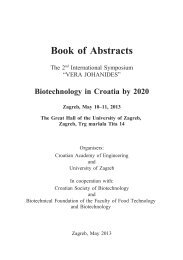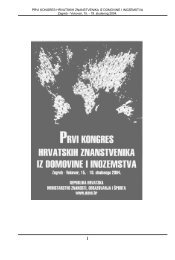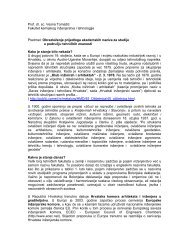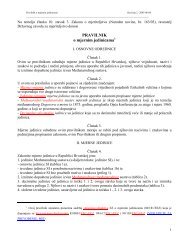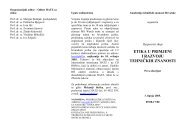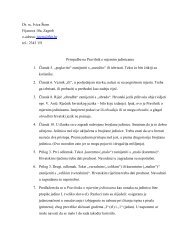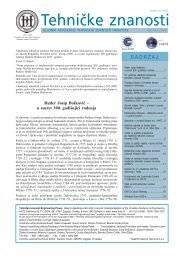annual 2010/2011 of the croatian academy of engineering - HATZ
annual 2010/2011 of the croatian academy of engineering - HATZ
annual 2010/2011 of the croatian academy of engineering - HATZ
Create successful ePaper yourself
Turn your PDF publications into a flip-book with our unique Google optimized e-Paper software.
Annual <strong>2010</strong>/<strong>2011</strong> <strong>of</strong> <strong>the</strong> Croatian Academy <strong>of</strong> Engineering 27<br />
Figure 6 Elementary ber <strong>of</strong> Spanish Broom, recorded with scanning electron microscope (SEM<br />
FE/Mira Tescan);<br />
THE APPLICATION OF SPANISH BROOM IN HISTORY<br />
Spanish Broom is a plant that was known even to <strong>the</strong> ancient Romans. In <strong>the</strong> past, Greeks,<br />
Romans and Carthaginians used it as raw material for <strong>the</strong> manufacture <strong>of</strong> ropes, nets, bags,<br />
sails. They also used it for covering ro<strong>of</strong>s and even clothing. The ower <strong>of</strong> <strong>the</strong> Spanish<br />
Broom is important for <strong>the</strong> coastal apiculture. Aristotle and Pliny praised <strong>the</strong> honey produced<br />
from Spanish Broom. In general, out <strong>of</strong> all ancient writers about Spanish Broom, it<br />
was Pliny Senior who wrote <strong>the</strong> most. He called it genista and he writes: Ginestra quoque<br />
vinculi,… ores apibus gratissimi (Spanish Broom is used for tying and making crumples,…<br />
and bees <strong>of</strong>ten land on its owers).<br />
However, in several places he mentions a plant called Spartum (Latin form <strong>of</strong> <strong>the</strong> Dioskorides’<br />
description <strong>of</strong> <strong>the</strong> plant sparton). After a detailed analysis <strong>of</strong> <strong>the</strong> application and<br />
processing, it is regarded <strong>the</strong> same plant today, or ra<strong>the</strong>r (Spartium Junceum L.). Already in<br />
<strong>the</strong> period <strong>of</strong> <strong>the</strong> ancient Rome, Spanish Broom elds (genestium – or ager in later Latin)<br />
were cultivated as any o<strong>the</strong>r eld, and <strong>the</strong> plant or sprouts were sown in ploughed up furrows,<br />
as <strong>the</strong> Roman agronomist Columella describes. According to Vergil, hedges <strong>of</strong> Spanish<br />
Broom were planted in addition to willow, hazel, elder and o<strong>the</strong>r plants. Pliny wrote<br />
that <strong>the</strong> sowing and planting <strong>of</strong> Spanish Broom was crucial for peasants. Amongst o<strong>the</strong>r<br />
things, its branches provide excellent material for tying vine and young trees.<br />
The most intensive production <strong>of</strong> Spanish Broom as raw material for obtaining textile fabric<br />
was in Italy during <strong>the</strong> 1930’s, when <strong>annual</strong> production <strong>of</strong> Spanish Broom, due to economic<br />
sanctions in Italy (war in Abyssinia) and <strong>the</strong> proclamation policy <strong>of</strong> self-sufciency,<br />
reached 700,000 tones. It was planted on 300,000 hectares and <strong>the</strong>re were 61 processing<br />
factories [2].





